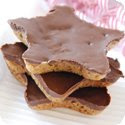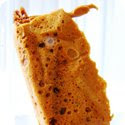Photo on Left: Reka Nyari's "My Neck" {posted with permission}
I look at necks differently now.
I see necks without scars
And remember when I didn't worry about my health.
When I took it for granted.
I have a scar on my neck.
In the checkout line at the grocery store,
I glance at people's necks
instead of the display of celebrity magazines.
Some are old.
Some are strong.
Some are wrinkly.
Some are taut.
I find myself laughing
with my head back
exposing my neck,
and then embarrassed
and vulnerable
I hide.
I'm searching.
For understanding.
For acceptance.
For a voice.
For life.
Today I wear cancer on my neck.
Someday I'll just wear a scar.
What could be more soothing than a velvety, smooth, deliciously flavoured soup awakening your taste buds and then gliding down your throat to fully satisfy those hunger pangs?
To say that
some like it hot may cause one to think of the 1959 Billy Wilder movie of the same name starring Tony Curtis who died last week (September 29, 2010). However, in this case, I’m referring to Leek and Potato Soup, sometimes known as Vichyssoise (vi-shē-swäz), a thick soup made of puréed leeks, potatoes, cream, and water (or sometimes chicken stock). It is traditionally served cold but – some like it hot. I am one of those who prefer my soup hot. But this versatile soup can be served either hot or cold, on its own, or as a sauce over seafood.
The origin of this soup has been debated. It is generally agreed that a French chef born in a town near Vichy in France was the first creator of this soup. French chef Jules Gouffé published a recipe that included potatoes, leeks, chicken stock, and cream in a cookbook entitled Royal Cookery in 1869. In this cookbook, the chef recommended that it be served hot. Another form of this recipe appears even earlier under the name Potage Parmentier, after a man named Antoine Auguste Parmentier who returned from a German prison-of-war camp after the Seven Year War (1756-1763) and, noting the sad plight of his people, set up potato soup kitchens in the city of Paris to feed the poor.
This soup became popularized in America, at the Ritz Carlton Hotel in New York City. Louis Diat was a chef at this hotel for the first half of the 20th century.
"In the summer of 1917, when I had been at the Ritz seven years, I reflected upon the potato-and-leek soup of my childhood, which my mother and grandmother used to make. I recalled how, during the summer, my older brother and I used to cool it off by pouring in cold milk, and how delicious it was. I resolved to make something of the sort for the patrons of the Ritz."
- Diat in the New Yorker magazine (1950)
The article goes on to say that the soup was first called crème vichyssoise glacée but when the restaurant’s menu changed from French to English in 1930, Diat named his invention after Vichy, a town near his home in France.
Tips
• It’s important to clean the leeks thoroughly. Since they are covered in sandy soil as they grow, sand can easily get embedded into the leek. Gritty sand is not a pleasing addition to this smooth soup so be sure to take the time to wash the leeks very carefully.
• Do not overcook the leeks since that will cause them to lose their brilliant, green color.
At Le Cordon Bleu
For one of the practicals at Le Cordon Bleu, we had to make Potage Julienne d'Arblay, a version of this classic leek and potato soup. The hardest part of this practical was cutting the carrots, turnips, and leeks into julienne. The length of my turnips was shorter than my carrots, so I lost marks on that. As well, I over-salted my soup. And I sautéed my croutons in too much clarified butter so when I presented my dish to the chef, he pressed a crouton in his fingers and showed me all the butter left on his hands. I thought that the more butter, the better!
Recipe: Leek and Potato Soup
Serves: 6
Ingredients:
30 g butter
150 g leeks, white parts only
500 g potatoes
750 ml water
Salt
Garnish:
50 g carrots
50 g turnips
50 g leeks, white parts only
50 g butter plus 50 g clarified butter
Finishing:
3 branches chervil (you could use parsley)
50 ml cream
50 g white bread slices
Instructions:
- Clarify Butter: In a bain marie (double boiler), clarify butter.
- Prepare the Leeks: Clean and slice the leeks into ½-inch thin slices. Set aside some for the garnish.
- Sweat the Leeks: Melt 50 g butter in a large pot and sweat the leeks until translucent, about 2 minutes.
- Cook the Potatoes: Peel and chop the potatoes. Add them to the pot with the leeks and add enough water to just cover the potatoes (about 500 ml). Bring to a simmer and cook, adding a pinch of salt.
- Prepare the Garnish: Julienne the carrots, turnips, and leeks. Cook each vegetable separately with a little butter, a touch of water, and a dash of salt, covering them while cooking for 1-2 minutes. This technique is called Étuvé. Once cooked, mix all the vegetables together and set aside.
- Blend the Soup: When the potatoes are fully cooked (a knife should easily slide in), pass the soup through a food mill to purée. If the soup is too thick, add water to adjust the consistency. Add the cream and heat the soup over low heat. Taste and adjust seasoning as needed.
- Strain the Soup: Pour the soup through a fine-mesh strainer (chinois) and cover with plastic wrap to keep warm.
- Make the Croutons: Cut the bread into cubes and sauté in clarified butter until golden brown. Drain on paper towels.
- Serve: Ladle the soup into bowls, and garnish with the cooked vegetables, croutons, and fresh chervil (or parsley).
This soup, with its few ingredients, offers a surprising depth of flavor. While the original recipe is simple, it can be adapted with ingredients like bacon, garlic, or curry for an added twist. Just remember—don’t over-salt the soup! When prepared correctly, Leek and Potato Soup becomes a comforting classic that’s perfect for any season.
Links
Reka Nyari:
website and portfolio
Jan von Holleben:
portfolio of necksMore to Explore:



















































